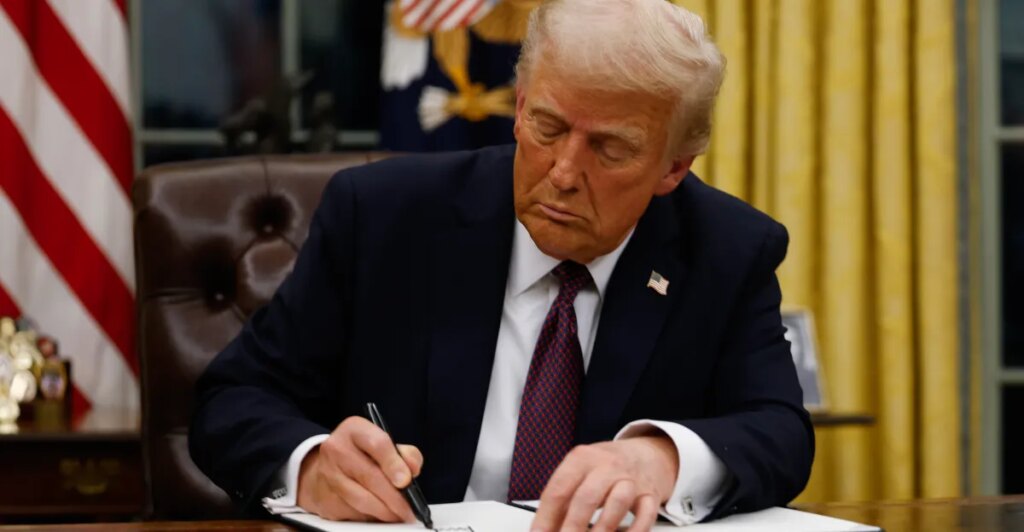President Donald Trump is considering signing an executive order as soon as Friday that would give the federal government unilateral power over regulating artificial intelligence, including the creation of an “AI Litigation Task Force” overseen by the attorney general, “whose sole responsibility shall be to challenge State AI laws.”
According to a draft of the order obtained by The Verge, the Task Force would be able to sue states whose laws are deemed to obstruct the growth of the AI industry, citing California’s recent laws on AI safety and “catastrophic risk” and a Colorado law that prevents “algorithmic discrimination.” The task force will occasionally consult with a group of White House special advisers, including David Sacks, billionaire venture capitalist and the special adviser for AI and crypto.
In recent days, Trump has repeatedly posted his desire to have a state AI law moratorium, and reiterated it on Wednesday during his appearance at the US-Saudi Investment Forum, couching it as a way to fight “woke” ideology. “You can’t go through 50 states. You have to get one approval. Fifty is a disaster. Because you’ll have one woke state and you’ll have to do all woke. You’ll be back in the woke business. We don’t have woke anymore in this country. It’s virtually illegal. You’ll have a couple of wokesters.”
As part of the AI Action Plan released earlier this year, Trump had directed several federal agencies, including the FCC, to explore ways that they could circumvent “onerous” state and local regulations in order to promote the industry’s growth and innovation. The full executive order lays out a 90-day roadmap for several key agencies to implement that plan along with the Department of Justice: the Federal Trade Commission, the Department of Commerce, and the Federal Communications Commission.
Within 90 days of the order being signed, the secretary of commerce will be directed to publish a report identifying which states are in violation of Trump’s AI policy directives, as well as research which states may become ineligible for the Broadband Equity Access and Deployment (BEAD) program, which funds rural broadband access for several states. The FTC, meanwhile, will be directed to issue a statement on whether states that require AI companies to change their algorithms would be in violation of laws prohibiting unfair and deceptive practices.
During an appearance at Politico’s AI & Tech Summit in September, FCC Commissioner Brendan Carr floated one potential interpretation of the Communications Act that would allow them to override state law. “Effectively, if a state or local law is effectively prohibiting the deployment of this ‘modern infrastructure,’ then the FCC has authorities to step in there,” he told Politico’s Alex Burns.
Carr also brought up the possibility that the FCC’s regulatory powers could override a potential new law in California that would have required AI companies to disclose their safety testing models, saying that it would fulfill Trump’s goal of blocking “woke AI” that contained ideological biases.
He cited the European Union’s Digital Safety Act and raised his concern “their AI models are not going to be truth-seeking AI models, but they’re going to be woke AI models, going to be AI models that are promoting DEI. And so again, President Trump has, as part of his action plan, steps to make sure that we don’t have that type of woke DEI embedded AI models developing here. When it comes to California, again, not familiar exactly with all the intricacy of that, but to the extent that they’re moving in that direction and away from truth seeking, it could be a problem.”
The notion that the FCC should have veto power over state AI laws — as well as other parts of Trump’s order — could easily be challenged in court. But moves like the litigation task force could still throw up roadblocks to states regulating AI.
Punchbowl News reported on Wednesday that the executive order is the White House’s backup plan should Congress fail to pass a state AI law moratorium, this time via the upcoming reauthorization of the National Defense Authorization Act — a bill that absolutely must pass in order for the government to fund its national security apparatus.
Earlier this year, Congress attempted to slip a moratorium into a draft of Trump’s “Big Beautiful Bill” that laid out the spending for his second-term agenda, but it failed after a bipartisan group of senators voiced opposition to the act. Earlier this week, House Majority Leader Steve Scalise told Punchbowl News that Congress was considering a second run at a moratorium by attaching it to the NDAA.
But just like the Big Beautiful Bill fight, a moratorium buried inside the NDAA’s passage might run into opposition particularly if the punishment is the same: the withholding of rural broadband funding. “The real question is, how big of a grant does it take to put pressure on state lawmakers to change their AI regulations?” said Thierer. “This came up in the previous moratorium fight and some people worried that California would just ignore BEAD-related budget threats, for example. It might take multiple budget revocations or limitations to really put pressure on a state as big as California.”
Follow topics and authors from this story to see more like this in your personalized homepage feed and to receive email updates.
- AIClose
AI
Posts from this topic will be added to your daily email digest and your homepage feed.
FollowFollow
See All AI
- PolicyClose
Policy
Posts from this topic will be added to your daily email digest and your homepage feed.
FollowFollow
See All Policy

